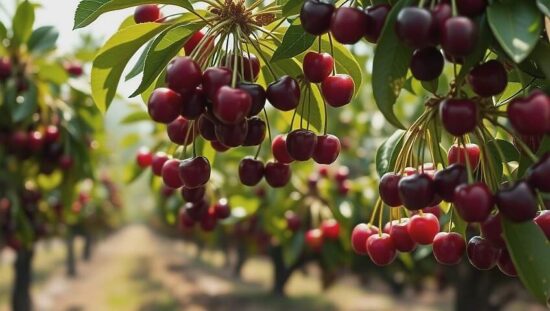German fruit growers have reported a strong cherry harvest for the summer of 2025. According to final estimates released Monday by the Federal Statistical Office (Destatis), a total of 47,100 tonnes of cherries were harvested. This comprised 79% (37,300 tonnes) of sweet cherries and 21% (9,800 tonnes) of sour cherries.
The 2025 harvest represents a 4.2% increase compared to the ten-year average for 2015-2024, which stood at 45,200 tonnes. Compared to the significantly below-average total harvest of 35,400 tonnes in 2024, production increased by approximately 11,700 tonnes, a rise of 33.1%.
The final estimate for sweet cherry production was 37,300 tonnes, a substantial increase of 9,400 tonnes (33.6%) above the very low figure recorded in 2024 due to weather conditions. This also represents a 4,400-tonne (13.3%) increase compared to the ten-year average of 32,900 tonnes. The robust sweet cherry harvest was favored by mild weather during the blossoming period and a general absence of frost or hail damage across most growing regions.
Sweet cherries are cultivated on 5,700 hectares in Germany. Baden-Württemberg is the leading state for domestic sweet cherry production, accounting for 2,600 hectares. The state produced 17,600 tonnes, representing 47% of the total German sweet cherry harvest. Lower Saxony follows with 5,000 tonnes produced on 480 hectares. Despite larger sweet cherry growing areas, Rhineland-Palatinate (660 hectares) and Bavaria (540 hectares) yielded lower harvests of 3,700 and 1,800 tonnes respectively.
While Baden-Württemberg’s sweet cherry harvest was slightly lower (-1%) compared to the previous year due to a particularly strong performance in 2024, Lower Saxony witnessed a significant increase (+67%), mirroring gains in Rhineland-Palatinate (+76%) and Bavaria (+30%). These regional variations in year-on-year comparisons reflect the exceptionally good harvest experienced by Baden-Württemberg in 2024, which contrasted with weather-related losses in other regions.
The final estimate for sour cherry production totaled 9,800 tonnes, exceeding the very low, weather-impacted harvest of 7,500 tonnes in 2024 by 31.3%. An initial preliminary estimate of 11,700 tonnes in June had suggested a near alignment with the ten-year average of 12,300 tonnes, but the final figure ultimately fell short by 20.0%. The lower than anticipated harvest is also attributed to a reduction in cultivated area for sour cherries, shrinking from 2,000 hectares to 1,500 hectares (-25%).
Rhineland-Palatinate leads the country in terms of sour cherry growing area, with 460 hectares, followed by Saxony (300 hectares) and Baden-Württemberg (240 hectares). Rhineland-Palatinate generated the largest harvest at 2,700 tonnes (+40% compared to the previous year), followed by Thuringia (1,900 tonnes, +179%) and Saxony (1,800 tonnes, +1,249%). These changes underscore the exceptionally challenging harvest year experienced in 2024, particularly in certain eastern German states where harvests were nearly complete failures.





